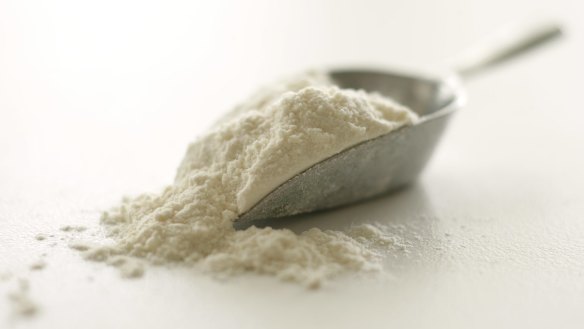How to choose the right flour for the right baking recipe

- A guide to gluten-free baking and alternative flours
- Baking recipes from Dan Lepard
- Helen Goh's baking recipes
You probably have a bag of flour in your pantry. And it's probably plain, the workhorse of baking. But there are plenty of other, more specialised flours out there, and even if you're just starting to dabble in baking, it will help to have a basic understanding of flour varieties.
The biggest difference to consider is protein content, which is often referred to in percentages. When water interacts with the proteins in your flour, it forms elastic sheets of gluten, giving baked goods the ability to rise and the stability to stay that way. So, more protein means more gluten will be formed, and the amount of structure and chew you're after will affect what flour you use.
Here's a rundown of the major types:
Plain
The jack of all trades, hence the name. This versatile staple is what you'll be pulling out most times you want to make almost anything: cookies, cakes, muffins, brownies, and even some breads and pizza dough. So if you're going to keep one type of flour in your pantry, this is it. The brand you use does make a difference to a certain extent, since protein content can vary from 10 to 12 per cent.
Wholemeal
As the name indicates, it's made from the entire wheat kernel, including the bran (protective outer layer), endosperm (the starchy food for the seed that surrounds it, used in white flour) and germ (the seed). Its protein content is 13 to 14 per cent. The fat in the wheat germ can go rancid, which is why it should be stored in the fridge or freezer. Wholemeal flour will give your baked goods a nuttier flavour, darker colour and heartier texture. Try it in muffins, quick breads and rustic yeasted loaves.
In recipes calling for plain flour, you can typically substitute one-third to one-half wholemeal flour without altering the result too much, although breads can be more problematic since the bran can cut through the gluten strands. If you want to go higher than that, you may need to start adding more liquid or seek out a recipe designed specifically for wholemeal flour. White wholemeal flour is milder in flavour and lighter in colour, making it a safer bet for large-scale substitutions.
Bread or baker's flour
Best for bread (obviously) and other baked goods that use yeast. The higher protein content – about 12 to 14 per cent – helps create more gluten, which gives bread its characteristic chew. That stretch is what allows a dough to rise without collapsing under the slow-acting power of yeast. When making more delicate baked goods such as cake or cookies, use bread flour in place of plain only at your peril; the swap will probably cause whatever you are baking to come out tough and dense.
High gluten
Similar to bread flour, but with a slightly higher protein content (14 per cent). This is mostly available online and probably not worth it if you are a typical home baker.
Pastry
Made with softer wheat, pastry flour has a protein content of about 9 per cent. It's not something even a relatively avid baker will need very often, although some people swear by it for delicate, flaky pie crusts.
Self-raising
This is lower-protein (around 8 to 10 per cent) plain flour with salt and baking powder mixed in. In lieu of self-raising flour, make your own by adding two teaspoons of baking powder to every cup (150 grams) of plain flour and sifting together.
Tipo 00
Italian Tipo 00 flour is essentially a fine high-protein flour with the consistency of talcum powder, traditionally used for making pizza dough and pasta.
The Washington Post
The best recipes from Australia's leading chefs straight to your inbox.
Sign up- More:
- How to